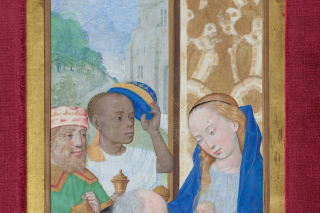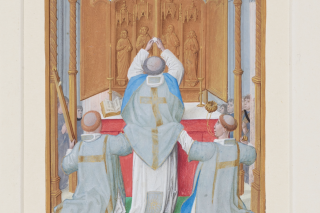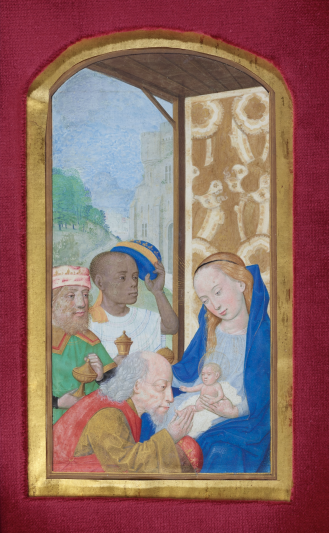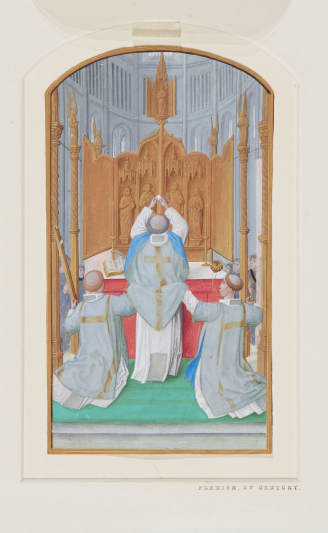Martin Kauffmann, Head of Early and Rare Collections, writes: The Hours of Louis Quarré (MS. Douce 311) is a lavishly illustrated manuscript, probably created in Ghent towards the end of the 15th century. Quarré, whose overpainted arms appear in the manuscript, was Seigneur de la Haye en Hainaut, rising in time to become Receiver General of Finances in the Burgundian court at Malines and Treasurer of the Order of the Golden Fleece. By the time the manuscript was acquired by Francis Douce in 1832 (and bequeathed to the Bodleian by him in 1834), several of its full-page miniatures had been removed. The Bodleian does not routinely seek to acquire single leaves and miniatures; but in this case it recognized the value of reuniting the miniatures with the original volume, and the generous support of the FNL and other bodies has made this possible.
The two miniatures represent the Adoration of the Magi and the Elevation of the Host. Both are cut to the shape of the miniature, with the loss of the original border. The Elevation originally marked the opening of the Saturday Mass of the Virgin, part of the Weekday Hours. It shows a priest, deacon, and subdeacon at an altar in a Gothic church, at the moment of consecration when the priest (with his back to the congregation) lifts the Host above his head. The Adoration marked the opening of the Office of the Virgin Mary at the sixth hour of the day (sext). The figures are of three different ages and are intended to represent Africa, Asia, and Europe. The appearance of the black king Balthazar is a noteworthy example of a pictorial innovation which was becoming established by this date.
The volume to which they belong is recognized as an outstanding example of Flemish manuscript illumination. The chief artist (perhaps personally responsible for the miniature of the Adoration but not for the Elevation) is known as The Master of the First Prayer Book of Maximilian, who has been tentatively identified with Alexander Bening (died 1519), father of Simon. The miniatures exemplify the artistic developments which accompanied new strands of individual religious devotion, including the use of the close-up which enhanced the drama and immediacy of the reader’s experience in their interaction with the figures depicted.
The manuscript belonged to Dominique Vivant, Baron Denon, Napoleon’s adviser on art plunder and first director of the Louvre. These two miniatures seem to have been removed (along with others) between the time that the manuscript was brought to England, perhaps by Robert Heathcote in 1816, and its acquisition by Douce. The removal of illuminated miniatures and initials from manuscripts, and their reframing as art objects, though reprehensible from a modern perspective, forms part of the history of their reception. Thereafter the two miniatures took different routes before being reunited in a modern private collection. Further miniatures survive in public collections in London, Paris, Amsterdam, and New York, as well as others still in private hands.



